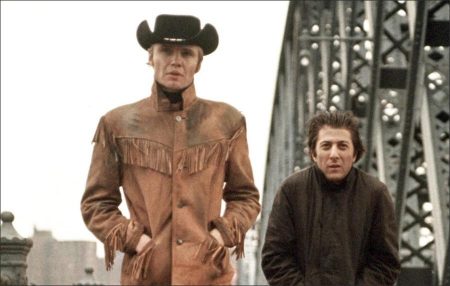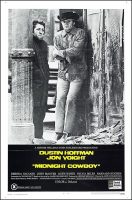Tagline: For those who have never seen it and those who have never forgotten it.
Midnight Cowboy movie storyline. Attired in urban cowboy garb, Joe Buck is a naive Texas hayseed having just arrived in New York City to make it big as a gigolo solely to his preferred clientèle of rich, attractive women. His belief in his charms on the female persuasion has been reinforced his entire life, he believes, by all the females with who he has had encounters, past and present, family, friends, and lovers.
However, life in New York City is not all he wants it to be, being out-hustled by most people he meets, they who he does not have the fortitude to hustle right back to get what he was originally due. Largely out of having nowhere else to turn, he eventually befriends one of those hustlers, a sickly man with a gimp leg named Enrico Rizzo, who is nicknamed Ratso by those who don’t much like him, that nickname which he doesn’t much like. Joe ends up squatting with Ratso in a room he has found in a condemned and thus otherwise empty building. As they lean on each other for support, they work together for their mutual benefit and survival. But as Ratso’s health deteriorates over the winter, Joe changes his focus to achieving Ratso’s dream of moving to Miami.
Midnight Cowboy (1969) is an ultra-realistic, adult film (shot on location) with sordid, downbeat and serious content, from British director John Schlesinger, who had previously directed the widely-acclaimed Darling (1965) – with a Best Actress win for Julie Christie. Jon Voight alongside Dustin Hoffman, Sylvia Miles, John McGiver, Brenda Vaccaro, Bob Balaban, Jennifer Salt, Barnard Hughes, George Eppersen, Linda Davis, Gary Owens, Al Scotta nd Anthony Holland.
This film portrays the unlikely companionship and poignant tragic drama of two homeless, down-and-out, anti-hero drifters who are powerfully bonded together in a tale resembling Steinbeck’s Of Mice and Men. With a misleading title for the morality tale about the venomous American class system, some viewers thought it was a western; in fact, the film’s title expresses the code name for a “male hustler”.
The self-professed occupation of one of the characters, a slow-witted, fringe-jacketed Texan dishwasher transplanted to the big, apathetic city of New York to hopefully become a high-paid street gigolo. The flip-side of this dark and serious buddy picture was its major competitor of the year, the M-rated, humorous revisionistic western/comedy Butch Cassidy and the Sundance Kid (1969) with its heroes Butch Cassidy (Paul Newman) and the Sundance Kid (Robert Redford).
It was notable for being the first and only X-rated film (its nude scenes and bold content – sex and drugs – were shocking for its time, but its X-rating for its initial release was later downgraded to R when the film was re-released in late 1970) to receive the Best Picture Oscar from the Academy of Motion Picture Arts and Sciences. It garnered seven nominations, including Best Actor (Dustin Hoffman and Jon Voight), Best Supporting Actress (Sylvia Miles in an extremely brief on-screen role), and Best Film Editing (Hugh A. Robertson), and ended up with three Oscars – Best Picture, Best Director, and Best Adapted Screenplay (by Waldo Salt from James Leo Herlihy’s 1965 novel). It was an archetypal film for the “New Hollywood” of the 70s, with its adult themes of alienation, sex and drugs, anti-authoritarianism, and a quest for freedom.
The opening scenes were filmed in Big Spring, Texas. A roadside billboard, stating “IF YOU DON’T HAVE AN OIL WELL…GET ONE!” was shown as the New York-bound bus carrying Joe Buck rolled through Texas. Such advertisements, common in the Southwestern United States in the late-1960s and through the 1970s, promoted Eddie Chiles’s Western Company of North America.
In the film, Joe stays at the Hotel Claridge, at the southeast corner of Broadway and West 44th Street in Midtown Manhattan. His room overlooked the northern half of Times Square. The building, designed by D. H. Burnham & Company and opened in 1911, was demolished in 1972. A motif featured three times throughout the New York scenes was the sign at the top of the facade of the Mutual of New York (MONY) Building at 1740 Broadway. It was extended into the Scribbage scene with Shirley the socialite, when Joe’s incorrect spelling of the word “money” matched that of the signage.
Midnight Cowboy (1969)
Directed by: John Schlesinger
Starring: Jon Voight, Dustin Hoffman, Sylvia Miles, John McGiver, Brenda Vaccaro, Bob Balaban, Jennifer Salt, Barnard Hughes, George Eppersen, Linda Davis, Gary Owens, Al Scott, Anthony Holland
Screenplay by: Waldo Salt
Production Design by: John Robert Lloyd
Cinematography by: Adam Holender
Film Editing by: Hugh A. Robertson
Costume Design by: Ann Roth
Set Decoration by: Philip Smith
Music by: John Barry
Distributed by: United Artists
Release Date: May 25, 1969
Visits: 145


